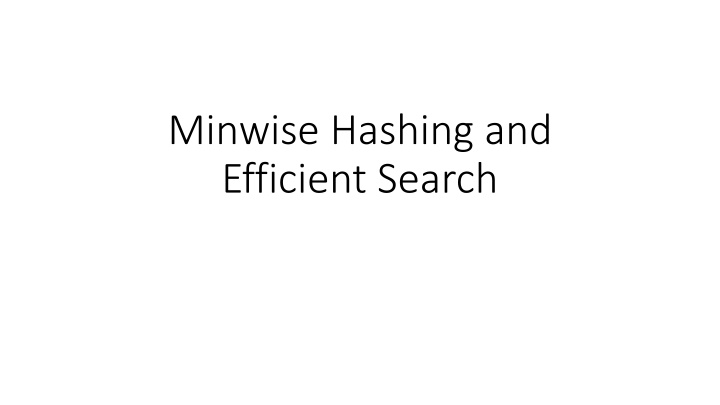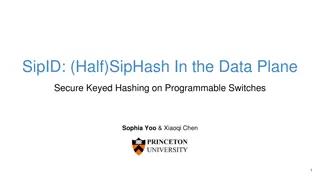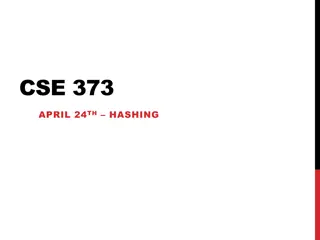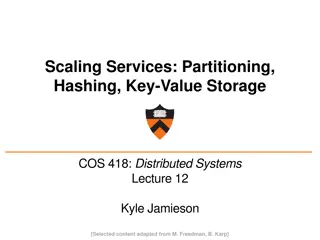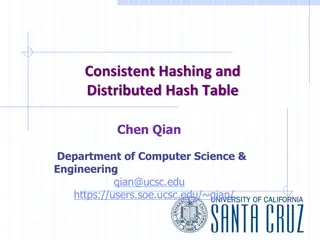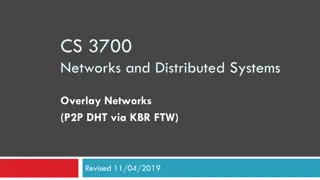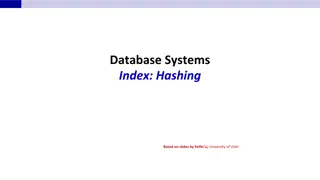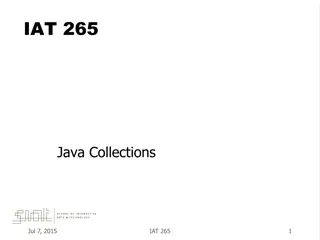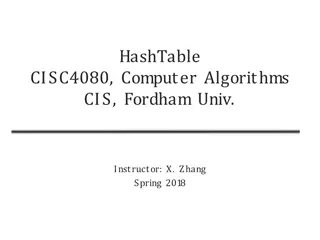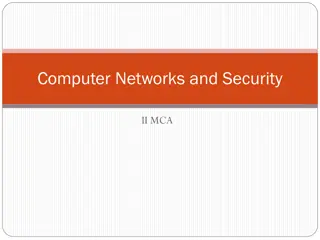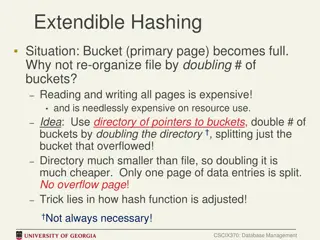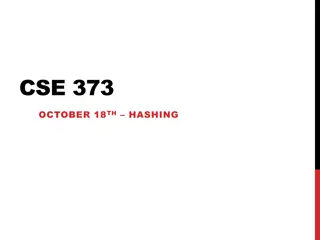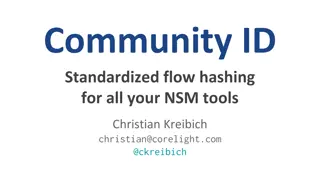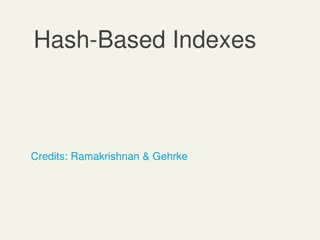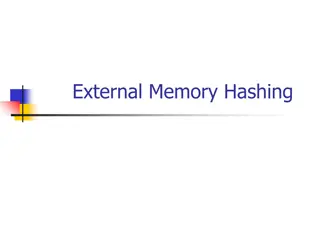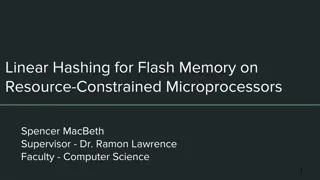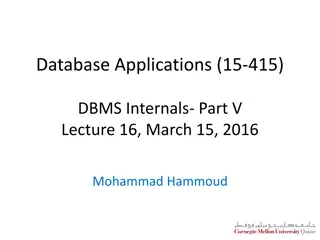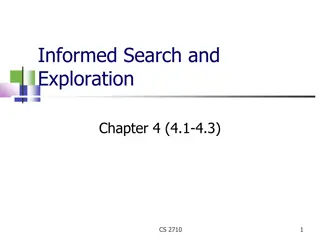Minwise Hashing and Efficient Search
Utilizing Minwise Hashing techniques for efficient large-scale image search in databases to find similar images quickly while overcoming memory constraints. Also, exploring hashing algorithms for removing duplicates and near-duplicates in arrays, along with space partitioning methods and near-neighbor search strategies for optimizing search operations in high-dimensional spaces.
Download Presentation

Please find below an Image/Link to download the presentation.
The content on the website is provided AS IS for your information and personal use only. It may not be sold, licensed, or shared on other websites without obtaining consent from the author.If you encounter any issues during the download, it is possible that the publisher has removed the file from their server.
You are allowed to download the files provided on this website for personal or commercial use, subject to the condition that they are used lawfully. All files are the property of their respective owners.
The content on the website is provided AS IS for your information and personal use only. It may not be sold, licensed, or shared on other websites without obtaining consent from the author.
E N D
Presentation Transcript
Minwise Hashing and Efficient Search
Example Problem Large scale search: We have a query image Want to search a giant database (internet) to find similar images Fast Accurate Picture Taken from Internet
Large Scale Image Search in Database Find similar images in a large database Kristen Grauman et al
Large scale image search Representation must fit in memory (disk too slow) Facebook has ~10 billion images (1010) PC has ~10 Gbytes of memory (1011 bits) Images are very high-dimensional objects. Fergus et al
Solution: Hashing Algorithms Simple Problem: Given an array of n integers. [1,2,3,1,5,2,1,3,2,3,7]. Remove Duplicates ? ?2,? ?log ? ?? ? ? ? What if we want near duplicates, so 1.001 is considered duplicate of 1? (more realistic)
Similarity or Near-Neighbor Search Given a (relatively fixed) collection C and a similarity (or distance) metric. For any query q, compute x = argmin ? ? 1. O(nD) per query, where n is size of C and D is dimentions. 2. Querying is a very frequent operations. 3. n and D are large Goal: Need something more efficient Hope: Preprocess Collections Approximate solutions are perfectly fine. ???(?,?)
Space Partitioning Methods Partition the space and organize database into trees In high dimensions, space partitioning is not at all efficient. Even D > 10, leads to near exhaustive Picture Taken from Internet
Motivating Problem: Search Engines Task: Correcting a user typed query in real-time. Take a database D of statistically significant query strings observed in the past. (around 50 million). Given a new user typed query q, find the closest string ? ? (in some distance) to q and return associated results. Latency: 50 million distance computation per query. A cheap distance function it takes 400s or 7min on a reasonable CPU. If you used edit distance, it will be hours. Latency Limit is roughly < 20ms. Can we do better? Exact solution: No Approximation: Yes. We can do it in 2ms or around 210000x faster!!
Locality Sensitive Hashing Classical Hashing if x = y h(x) = h(y) if x y h(x) h(y) Locality Sensitive Hashing (randomized relaxation) if sim(x,y) is high Probability of h(x) = h(y) is high if sim(x,y) is low Probability of h(x) = h(y) is low Many known families of similarity We will see one today. Conversely, h(x) = h(y) implies sim(x,y) is high (probabilistically)
Our Notion of Similarity: Jaccard Given two sets ?1 ??? ?2. Jaccard similarity is defined as J = sim ?1,?2 = | ?1 ?2| Simple Example: ?1= 3,10,15,19 , ?2= 4,10,15 ,? ?? ?? ?? ? ?1 ?2 ?1 ?2 ? What about strings? Weren t we looking at query strings?
N-grams are set! We will use character 3-gram representations Takes a string and converts it into set of all contiguous 3-characters tokens. String ?? ??? 6 ?? ,? ?, ??,???,?? ,? 6 What is the Jaccard distance (assuming character 3-gram representation) a????? ?? ?????? ???,???,???,??? ?? ???,???,???,??? =2 $??,???,???,???,???,??. ?? $??,???,???,???,???,??. =3 ?????? ?? ?????? ???,???,???,??? ?? ???,???,???,??? =3 $??,???,???,???,???,??. ?? $??,???,???,???,???,??. =4 a????? ?? ?????? 0 6=1 3 9=1 3 5 8=1 2
Random Sampling using universal hashing Given a set {Ama, maz, azo, zon} Given a random hash function ?:?????? 0 ? . Pr(h(s) = c) = 1/R Problem: Using ?, can we get a random element of the set? Probability of getting any element is equally likely (1/4) ? Solution: Hash every token using U, pick the token that has minimum (or maximum) hash value. Example: {U(Ama), U(maz), U(azo), U(zon)} = {10, 2005, 199, 2}. Random Sampled element is zon . Proof?
Minwise hashing (Minhash) Document : S = {ama, maz, azo, zon, on.}. Generate Random ??:??????? ?. Example: Murmurhash3 with new random seed i. ??? ={??(ama), ??(maz), ??(azo), ??(zon), ??(on.)} Lets say ??? = {153, 283, 505, 128, 292} Then Minhash: ? = min ?? = 128. New seed for hash function ??, a new minhash.
Properties of Minwise Hashing Can be applied to any set. Minhash: Set [0-R] (R is large enough) ?1 ?2 For any set ?1 ??? ?2 Pr ??? ?? ?1 = ??? ?? ?2 Proof: Under randomness of hash function U Fact1: For any set, the element with minimum hash is a random sample. Consider set ?1 ?2, and sample a random element e using U. Claim1: ? ?1 ?2if and only if ??? ?? ?1 = ??? ?? ?2 ?1 ?2 |?1 ?2| =
Estimate Similarity Efficiently ?1 ?2 |?1 ?2| = J Pr ??? ?? ?1 = ??? ?? ?2 = Given 50 minhashes of ?1 ??? ?2. How can we estimate J? Memory is 50 numbers. 0.16 50 0.05 Variance = J(1-J)/50, J = 0.8 ..roughly How about random sampling?
Parity of MinHash is good too Document : S = {ama, maz, azo, zon, on.}. Generate Random ??:??????? ?. Example: Murmurhash3 with new random seed i. ??? ={??(ama), ??(maz), ??(azo), ??(zon), ??(on.)} Lets say ??? = {153, 283, 505, 128, 292} Then Minhash: ? = min ?? = 128. Parity = 0 (even) (1-bit information) Pr ?????? ??? ?? ?1 = ??????(??? ?? ?2) = |?1 ?2| + 1 ?1 ?2 ?1 ?2 ?1 ?2 ?1 ?2 ?1 ?2 0.5 = 0.5 1 +
Parity of Minhash: Compression Given 50 parity of minhashes. How to estimate J? Memory is 50 bits or < 7 bytes (2 integers) Error for J = 0.8 is little worse than 0.05 (how to compute ?) Only depends on similarity and not on how heavy the set is!! Completely different tradeoff Set can have 100, 1000 or 10,000 elements, but the storage cost is the same for similarity estimation.
Minwise Hashing is Locality Sensitive ?1 ?2 |?1 ?2| = J Pr ??? ?? ?1 = ??? ?? ?2 J is high probability of collision is high J is low probability of collision is low. = Minhash is integer, can be used for indexing. Even parity can be used.
Locality Sensitive Hashing Classical Hashing if x = y h(x) = h(y) if x y h(x) h(y) Locality Sensitive Hashing (randomized relaxation) if sim(x,y) is high Probability of h(x) = h(y) is high if sim(x,y) is low Probability of h(x) = h(y) is low We will see how to have h for jaccard distance! Conversely, h(x) = h(y) implies Jaccard sim(x,y) is high (probabilistically)
Why is it helpful in search? Access to h(x) (with random seed), such that h(x) = h(y) Noisy indicator that Sim(x,y) is high.
Why is it helpful in search? Access to h(x) (with random seed), such that h(x) = h(y) Noisy indicator that Sim(x,y) is high. Given a query q, compute 1(?) = 01 and 2? = 11. Consider bucket 0111 as good candidate set. (Why?) We can turn this idea into a sound algorithm later.
Create multiple independent Hash Tables For every query, get the union of L buckets. K controls the quality of bucket. L controls failure probability. Optimal choice of K and L is provably efficient.
The LSH Algorithm Choose K and L (parameters). Generate K x L random seeds (for hash functions) Create L Independent Hash tables Preprocess Database D: For every ? ?, index it with location { ? 1 ?+1(?), ? 1 ?+1 ? , , ??(?)} in hash table i. O(LK) Query with q: Take union of L buckets from each hash table: Bucket { ? 1 ?+1 ? ; ? 1 ?+1 ? ; , ??(?)} in table i. Get the best elements from the union based on similarity with q
One implementation details { ? 1 ?+1(?), ? 1 ?+1 ? , , ??(?)} is a bucket? Use a universal hashing that take K integers and maps it to [0-R] Typically use ?1?1+ ?2?2+ + ???? + ? ??? ? ??? ?, choose ??s randomly. Negligible random collisions!! Insertion and deletion is straightforward!!
A bit of analysis ??= Pr(??? ?? ? = ??? ?? (?)) = ??????? Probability of collision in a hash table? ?? 1- ?? (1 ?? 1 (1 ?? 1 (1 ?? Ex: K = 5, L =10 ??> 0.8, Probability of retrieval > 0.98 ??< 0.5 Probability of retrieval < 0.2 ?(probability that x is in bucket mapped by q in hash table 1) ? is probability of x not in bucket mapped by q in hash table 1 ?)?is probability x is not in any of the L buckets. Or x is not retrieved ?)? is the probability that x is retrieved. ?)? is monotonic function of ??
More Theory Linear search O(n) LSH based search O(??), ? is function of similarity threshold and gap. Ignore the match Rule of Thumb: If we want very high similarity its very efficient (approaches O(1) in limit). Limits make sense? Rule of Thumb for Parameters: ? log ? ; ? ? (n is size of Database D) Increase in K decreases candidates retrieved exponentially Increase in L increases candidates linearly. Practice and play with different datasets and similarity levels to become expert.
